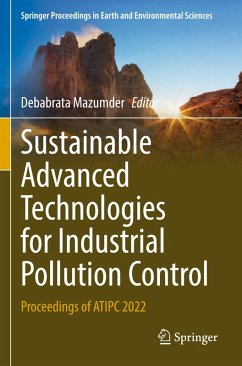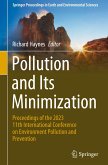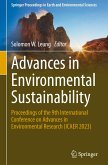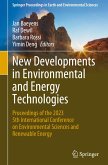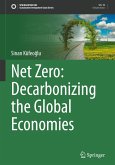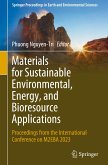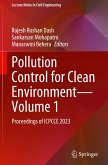Sustainable Advanced Technologies for Industrial Pollution Control
Proceedings of ATIPC 2022
Herausgegeben:Mazumder, Debabrata
Sustainable Advanced Technologies for Industrial Pollution Control
Proceedings of ATIPC 2022
Herausgegeben:Mazumder, Debabrata
- Broschiertes Buch
- Merkliste
- Auf die Merkliste
- Bewerten Bewerten
- Teilen
- Produkt teilen
- Produkterinnerung
- Produkterinnerung
This proceedings volume constitutes peer-reviewed full-length papers contributed by the Authors and tailored on various thematic areas of the 3rd International Conference on "Advanced Technologies for Industrial Pollution Control" (ATIPC - 2022). The areas of research covered by these papers include but are not limited to:
-Water quality monitoring and treatment in industrial area
-Industrial effluent treatment, reuse and conservation
-Monitoring of industrial emission and control -Industrial solid waste management
-Handling and disposal of hazardous waste
-Case Studies on…mehr
Andere Kunden interessierten sich auch für
![Sustainable Advanced Technologies for Environmental Management Sustainable Advanced Technologies for Environmental Management]() Sustainable Advanced Technologies for Environmental Management165,99 €
Sustainable Advanced Technologies for Environmental Management165,99 €![Pollution and Its Minimization Pollution and Its Minimization]() Pollution and Its Minimization164,99 €
Pollution and Its Minimization164,99 €![Advances in Environmental Sustainability Advances in Environmental Sustainability]() Advances in Environmental Sustainability149,99 €
Advances in Environmental Sustainability149,99 €![New Developments in Environmental and Energy Technologies New Developments in Environmental and Energy Technologies]() New Developments in Environmental and Energy Technologies138,99 €
New Developments in Environmental and Energy Technologies138,99 €![Net Zero: Decarbonizing the Global Economies Net Zero: Decarbonizing the Global Economies]() Sinan KüfeogluNet Zero: Decarbonizing the Global Economies187,99 €
Sinan KüfeogluNet Zero: Decarbonizing the Global Economies187,99 €![Materials for Sustainable Environmental, Energy, and Bioresource Applications Materials for Sustainable Environmental, Energy, and Bioresource Applications]() Materials for Sustainable Environmental, Energy, and Bioresource Applications186,99 €
Materials for Sustainable Environmental, Energy, and Bioresource Applications186,99 €![Pollution Control for Clean Environment-Volume 1 Pollution Control for Clean Environment-Volume 1]() Pollution Control for Clean Environment-Volume 1176,99 €
Pollution Control for Clean Environment-Volume 1176,99 €-
-
-
This proceedings volume constitutes peer-reviewed full-length papers contributed by the Authors and tailored on various thematic areas of the 3rd International Conference on "Advanced Technologies for Industrial Pollution Control" (ATIPC - 2022). The areas of research covered by these papers include but are not limited to:
-Water quality monitoring and treatment in industrial area
-Industrial effluent treatment, reuse and conservation
-Monitoring of industrial emission and control
-Industrial solid waste management
-Handling and disposal of hazardous waste
-Case Studies on industrial pollution control
-Innovative technologies in industrial waste management
-Water quality monitoring and treatment in industrial area
-Industrial effluent treatment, reuse and conservation
-Monitoring of industrial emission and control
-Industrial solid waste management
-Handling and disposal of hazardous waste
-Case Studies on industrial pollution control
-Innovative technologies in industrial waste management
Produktdetails
- Produktdetails
- Springer Proceedings in Earth and Environmental Sciences
- Verlag: Springer / Springer Nature Switzerland / Springer, Berlin
- Artikelnr. des Verlages: 978-3-031-37598-9
- 2023
- Seitenzahl: 424
- Erscheinungstermin: 22. September 2024
- Englisch
- Abmessung: 235mm x 155mm x 22mm
- Gewicht: 716g
- ISBN-13: 9783031375989
- ISBN-10: 303137598X
- Artikelnr.: 71772841
- Herstellerkennzeichnung
- Springer-Verlag GmbH
- Tiergartenstr. 17
- 69121 Heidelberg
- ProductSafety@springernature.com
- Springer Proceedings in Earth and Environmental Sciences
- Verlag: Springer / Springer Nature Switzerland / Springer, Berlin
- Artikelnr. des Verlages: 978-3-031-37598-9
- 2023
- Seitenzahl: 424
- Erscheinungstermin: 22. September 2024
- Englisch
- Abmessung: 235mm x 155mm x 22mm
- Gewicht: 716g
- ISBN-13: 9783031375989
- ISBN-10: 303137598X
- Artikelnr.: 71772841
- Herstellerkennzeichnung
- Springer-Verlag GmbH
- Tiergartenstr. 17
- 69121 Heidelberg
- ProductSafety@springernature.com
Dr. Debabrata Mazumder is a Professor in the Department of Civil Engineering at the Indian Institute of Engineering Science and Technology, Shibpur.
Chapter 1: Water decontamination through Thiamethoxam removal using DL menthol-octanoic acid Deep Eutectic Solvent : Molecular dynamics insights.- Chapter 2: Methyl Red dye abatement from aqueous solution using Calcium Ferrite and Manganese Ferrite magnetic nanocomposite: Kinetics and isotherm study.- Chapter 3: Adsorption of Fluoride onto PANI-Cl jute fibre - designing higher flow rate and initial concentration column reactor from a batch reactor.- Chapter 4: Biosynthesis of Nano Zero valent Iron (nZVI) using Shorea robusta Leaf Extract and its application in UV-assisted Photocatalytic Degradation of Methyl Orange.- Chapter 5: Method Development for detection of 2-Methylpyridine by High Performance Liquid Chromatography.- Part 2 - Industrial effluent treatment, reuse and conservation.- Chapter 6: Importance of cost functions for biological treatment of wastewater.- Chapter 7: Removal of heavy metals by Laterite soil.- Chapter 8: Removal of Methylene Blue from wastewater by Red Sandy soil-Based Alkali activated binder.- Chapter 9: Assessment and Treatment of iron from industrial wastewater using activated carbon derived from Parkia Speciosa pod.- Chapter 10: Activated Carbon developed from Phumdi biomass and Deccan Hemp for adsorption of Methylene Blue.- Chapter 11: An experimental study of Metanil Yellow dye remediation using Fe-Mn Bimetal oxide composites.- Chapter 12: Optimization of electrocoagulation process parameters using magnesium electrodes for treating pharmaceutical wastewater containing salicylic acid.- Chapter 13: Optimization of process parameters for biodegradation of Cresol by mixed bacterial culture using Response Surface Methodology.- Chapter 14: Biological degradation of Cresol containing wastewater using mixed microbial culture in presence of heavy metals.- Part 3 - Monitoring of industrial emission and control.- Chapter 15: Development of a simplistic model for the prediction of reactive air pollutants in the atmosphere.- Chapter 16: Controlling Air and Metal pollution in industrial area Singrauli, India: Role of plants.- Part 4 - Industrial solid waste management.- Chapter 17: Enhancing the dewatering ability of sludge by locally available biomass.- Chapter 18: Production of Xylose from Water Hyacinth Biomass (WHB) (lignocellulosic waste) for Xylitol production: waste to wealth.- Chapter 19: A simplistic mathematical model for two-stage Anaerobic Digestion of plastic wastes.- Part 5 - Handling and disposal of hazardous waste.- Chapter 20: Modeling migration of Cr(VI) contaminant through Clay Liner using Hydrus-3d.- Chapter 21: Electrokinetic remediation of total Chromium from contaminated soil.- Chapter 22: Low-Cost recovery of Cadmium from wastewater by soil bacteria.- Part 6 - Case Studies on industrial pollution control.- Chapter 23: Tannery waste management in India: A case study.- Chapter 24: Removal of natural organics and selected antibiotics using PAC and AL electrode: A study for Jumar River.- Chapter 25:Quantification of floating plastics using UAV images and Identification of Microplastics in Ukkadam tank.- Chapter 26: Study of wastewater treatment in Hindustan Coca-Cola plant at Khurda.- Part 7 - Innovative technologies in industrial waste management.- Chapter 27: In Vitro Performance Analysis of Ti and Zn doped Hydroxyapatite made from waste Eggshells.- Chapter 28: Production of non-toxic, non-polluting herbal soaps using plant extracts having anti-microbial activity.- Chapter 29: Decolourization of Textile Dye RR 141 using electrochemical process.
Chapter 1: Water decontamination through Thiamethoxam removal using DL menthol-octanoic acid Deep Eutectic Solvent : Molecular dynamics insights.- Chapter 2: Methyl Red dye abatement from aqueous solution using Calcium Ferrite and Manganese Ferrite magnetic nanocomposite: Kinetics and isotherm study.- Chapter 3: Adsorption of Fluoride onto PANI-Cl jute fibre - designing higher flow rate and initial concentration column reactor from a batch reactor.- Chapter 4: Biosynthesis of Nano Zero valent Iron (nZVI) using Shorea robusta Leaf Extract and its application in UV-assisted Photocatalytic Degradation of Methyl Orange.- Chapter 5: Method Development for detection of 2-Methylpyridine by High Performance Liquid Chromatography.- Part 2 - Industrial effluent treatment, reuse and conservation.- Chapter 6: Importance of cost functions for biological treatment of wastewater.- Chapter 7: Removal of heavy metals by Laterite soil.- Chapter 8: Removal of Methylene Blue from wastewater by Red Sandy soil-Based Alkali activated binder.- Chapter 9: Assessment and Treatment of iron from industrial wastewater using activated carbon derived from Parkia Speciosa pod.- Chapter 10: Activated Carbon developed from Phumdi biomass and Deccan Hemp for adsorption of Methylene Blue.- Chapter 11: An experimental study of Metanil Yellow dye remediation using Fe-Mn Bimetal oxide composites.- Chapter 12: Optimization of electrocoagulation process parameters using magnesium electrodes for treating pharmaceutical wastewater containing salicylic acid.- Chapter 13: Optimization of process parameters for biodegradation of Cresol by mixed bacterial culture using Response Surface Methodology.- Chapter 14: Biological degradation of Cresol containing wastewater using mixed microbial culture in presence of heavy metals.- Part 3 - Monitoring of industrial emission and control.- Chapter 15: Development of a simplistic model for the prediction of reactive air pollutants in the atmosphere.- Chapter 16: Controlling Air and Metal pollution in industrial area Singrauli, India: Role of plants.- Part 4 - Industrial solid waste management.- Chapter 17: Enhancing the dewatering ability of sludge by locally available biomass.- Chapter 18: Production of Xylose from Water Hyacinth Biomass (WHB) (lignocellulosic waste) for Xylitol production: waste to wealth.- Chapter 19: A simplistic mathematical model for two-stage Anaerobic Digestion of plastic wastes.- Part 5 - Handling and disposal of hazardous waste.- Chapter 20: Modeling migration of Cr(VI) contaminant through Clay Liner using Hydrus-3d.- Chapter 21: Electrokinetic remediation of total Chromium from contaminated soil.- Chapter 22: Low-Cost recovery of Cadmium from wastewater by soil bacteria.- Part 6 - Case Studies on industrial pollution control.- Chapter 23: Tannery waste management in India: A case study.- Chapter 24: Removal of natural organics and selected antibiotics using PAC and AL electrode: A study for Jumar River.- Chapter 25:Quantification of floating plastics using UAV images and Identification of Microplastics in Ukkadam tank.- Chapter 26: Study of wastewater treatment in Hindustan Coca-Cola plant at Khurda.- Part 7 - Innovative technologies in industrial waste management.- Chapter 27: In Vitro Performance Analysis of Ti and Zn doped Hydroxyapatite made from waste Eggshells.- Chapter 28: Production of non-toxic, non-polluting herbal soaps using plant extracts having anti-microbial activity.- Chapter 29: Decolourization of Textile Dye RR 141 using electrochemical process.

